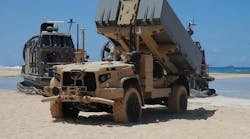By J.R. Wilson
SAN FRANCISCO — Engineers from Thales Computers (formerly Cetia) are emphasizing PowerPC-based solutions for signal processing, rugged systems, racks, integrated systems, single-board computers, and PCI mezzanine cards — better known as PMCs.
This was the word from Thales officials at the Embedded Systems Conference in San Francisco April 10, at which they made two announcements concerning their dual-track interest in PowerPC and Pentium III microprocessor applications.
Thales's first announcement was the release of its PowerLine4 real-time software development suite, designed to optimize Motorola's AltiVec technology for PowerPC G4 applications.
The second announced availability of the PENTX3 single board computer (SBC), designed around the Intel Pentium III processor at 500 MHz. The board supports a 100 MHz memory bus and a 33 MHz PCI interface.
"We are mainly on the PowerPC market, but we also see some demand for the P-III," says Philippe Vincent, vice president-product of marketing and services for Thales, located in Toulon, France, and Raleigh, N.C. "Our strategy is opportunistic."
Thales officials say their G4 PowerEngine boards with PowerLine4 are appropriate for design of data-, signal-, and image-processing machines on top of commercial off-the-shelf (COTS) real-time operating systems. In one chip, AltiVec is a vector-processing PowerPC that does high-bandwidth data processing and algorithmic-intensive computations.
The Thales Computers G4 PowerEngine boards with embedded PowerLine4 software are part of radar and sonar applications with Thomson Marconi Sonar for the French, U.K. and Australian navies' mine-hunting systems.
"Thales Computers's G4 hardware and software solutions are also used in a number of U.S. development programs — applications from vehicle control to secure communications to simulation," says Product Manager Vincent Chuffart. Pricing for the G4 PowerEngine single-board computer with PowerLine4 starts at $7,250.
The PENTX3 is available in 6U VME convection-cooled, militarized, conduction-cooled and non-VME versions. Thales officials tout it as the first fully featured Pentium III-based single-board computer available in one slot for embedded applications in harsh environments. The PENTX3 is available with Windows NT, QNX or VxWorks, starting at $3,795.
Vincent says about 75 percent of Thales's global business is defense and aerospace — with defense reporting a 30 percent growth last year alone — but they hope to see substantial future growth in their commercial markets.
"It doesn't depend on our marketing so much as the successes of our customers," he says.
"We have some good seed in those (commercial) markets that could bring revenues up," adds Hubert Canuet, vice president-worldwide sales, "but hopefully the military side will grow, as well. Last year's growth was due to products based on the G4, mostly in the signal processing market. That's where the majority of the growth is coming from. In some cases, they can use the same processor for both signal and data processing."



